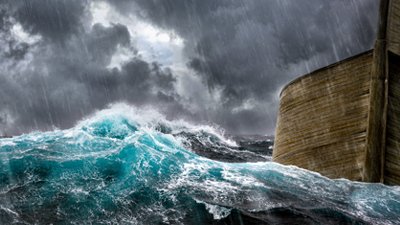Death Valley Stream Shows Range of Geological Changes
Amid the otherworldly Death Valley of California, geologists are seeing a 1941 stream diversion carve out the land before their very eyes.
News Source
Death Valley holds the record for the hottest, driest place in North America and sits at an extreme elevation of 282 ft (86 m) below sea level. In this strange environment, rivers cannot flow out to sea, but nonetheless can ravage the land during flash floods—giving geologists “a rare glimpse into a range of geological changes that might otherwise take centuries to unfold.”
The wash has been diverted by a dam since the 1940s.
Boston College geologist Noah Snyder and BC graduate Lisa Kammer took a close look at Gower Gulch, carved over the past 66 years by Furnace Creek Wash. The wash has been diverted by a dam since the 1940s that protects a village from flash flooding during rare rainstorms; it has since sliced the gulch out of the sandy hills and sedimentary rock surrounding it.
The team’s study of Gower Gulch, published in this month’s edition of Geology, included review of 50 years of aerial photography and a laser-based study of the region’s elevation. The results are an intriguing reminder of the catastrophic power of water, as the press release explains:
[A]t some points, the creek cuts into the land, leaving deep slices in the bedrock from the surge of flood waters brought on by as little as a half-inch to an inch of rain falling over the watershed that rolls out of the Funeral Mountains. At other points, where soft, sedimentary rocks sit below the surface, the creek has had a widening effect on its channel.
The press release also notes—and this is important—that water’s ability to reshape the earth is not due to “the steady flow of a routinely-fed creek or river,” but is instead the result of periodic storms. “Under normal conditions,” the release explains, “the effects of rivers and streams take eons to clearly manifest themselves in the land.” But with the combination of man-made diversions and flash flooding, such eons of geological work can take place over a short period of time.
The connection to Noah’s Flood and the young-earth model of geology should, by this point, be pretty obvious: as we (and others) have emphasized for what seems like eons, a lot of water over a little time—as in the case of floods or the Flood—can do at least as much geological work as a little water over a lot of time. In fact, the Boston College team’s research, as noted in the previous paragraph, suggests that flooding—not the slow flow of water—is almost exclusively responsible for the observed geological carving (at least in the case of Gower Gulch).
Substantial amounts of water can have the same geological effect in a short period of time that hypothesized millions of years of slow water flow would have.
Furthermore, the effects of Furnace Creek Wash are viewable before geologists’ eyes; they are not hypothesized effects over millions of years that are outside the realm of scientific observation. Gower Gulch, the press release notes, gives geologists a natural field for experimentation.
Geologists repeatedly discover the catastrophic effects of local flooding on the earth’s surface, resulting in the same conclusion each time: that substantial amounts of water can have the same geological effect in a short period of time (even laying down rock layers) that hypothesized millions of years of slow water flow would have. For instance, back in October we reported on Canyon Lake Gorge in Texas, a canyon up to 80 ft (24 m) deep that was chiseled out in three days in 2002 when a spillway overflowed.
It’s abundantly clear, based on the work of geologists who accept Noah’s Flood and those who don’t, that flooding has the power to rework the earth’s surface. The effects of a worldwide, earth-covering flood that involved both rain from above and the fountains of the deep opening from below would, over the course of the year it lasted, have geological effects almost beyond our imagination and could have easily accounted for characteristics of the earth’s surface we see today: a world ravaged by catastrophic water flow. What, ultimately, does this mean? The Grand Canyon and its ilk are not testaments to millions of years of evolution, but rather signposts of the righteous judgment of God that came—and reminders of the one to come (II Peter 3:10).
Further Reading
For More Information: Get Answers
Remember, if you see a news story that might merit some attention, let us know about it! (Note: if the story originates from the Associated Press, FOX News, MSNBC, the New York Times, or another major national media outlet, we will most likely have already heard about it.) And thanks to all of our readers who have submitted great news tips to us. If you didn’t catch all the latest News to Know, why not take a look to see what you’ve missed?
(Please note that links will take you directly to the source. Answers in Genesis is not responsible for content on the websites to which we refer. For more information, please see our Privacy Policy.)

Answers in Genesis is an apologetics ministry, dedicated to helping Christians defend their faith and proclaim the good news of Jesus Christ.
- Customer Service 800.778.3390
- © 2024 Answers in Genesis




